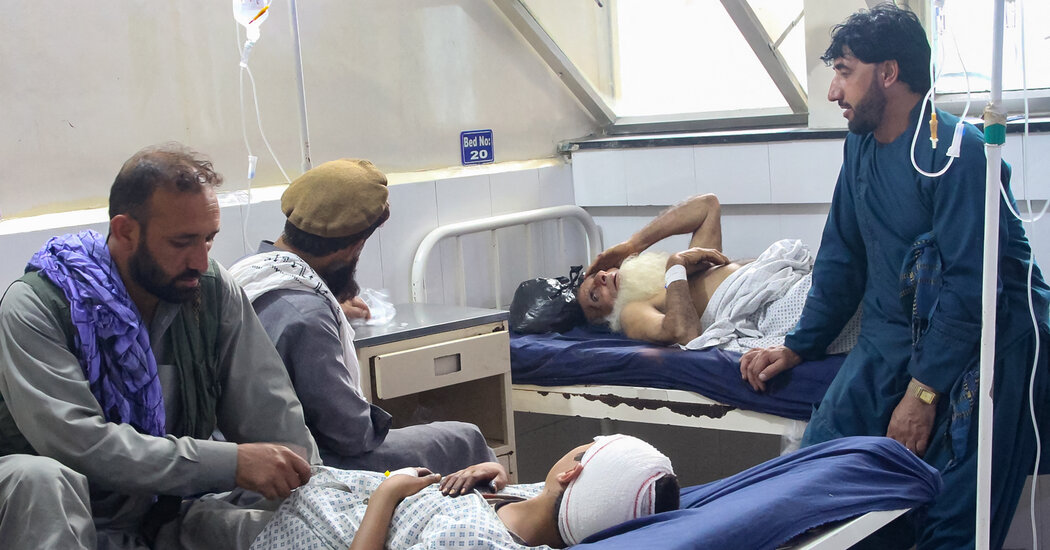A 6.0-magnitude earthquake hit eastern Afghanistan overnight, killing hundreds of people and injuring more than 1,000 others, the authorities said on Monday.
Rescue workers were rushing to reach communities in mountainous areas hit by the quake, which sent strong aftershocks into Kabul, the capital.
The death toll is expected to rise significantly.
Where are the hardest-hit areas?
The epicenter was near Jalalabad, an eastern city of about 200,000 people. The city is less than 100 miles from Kabul, the capital, and close to the Pakistan border.
The quake was shallow, just five miles from the earth’s surface, which made it more likely to be destructive. Soon after the initial shaking stopped, people scrambled in the middle of the night to reach neighbors trapped under the debris of collapsed houses, according to videos shared on social media.
At least four eastern Afghan provinces — Nangarhar, Nuristan, Laghman and Kunar — had been affected by the quake, said Kate Carey, the deputy head of the United Nations’ office of humanitarian affairs in Afghanistan.
Tremors were also felt in neighboring Pakistan across several districts of the northwestern border province of Khyber Pakhtunkhwa as well in as parts of Punjab Province, the Pakistan-administered part of Kashmir and the capital, Islamabad, the Pakistan Meteorological Department said. No major damage or casualties were immediately reported in Pakistan, officials said.
How many people are affected?
The Afghan authorities said on Monday morning that the quake had killed more than 600 people and injured more than 1,300. Several villages were destroyed, Sharafat Amar, a spokesman for Afghanistan’s Ministry of Health, said on X.
Officials warned that the toll was likely to climb as rescuers reach the hardest-hit areas.
What challenges complicate the response?
Steep terrain in the worst-affected areas will pose a challenge to rescue workers, as the quake sent landslides over roads, Ms. Carey said.
The quake is the latest in a series of overlapping crises for Afghanistan. Less than 30 percent of its humanitarian needs are covered for 2025, according to the U.N., and more than half of its 42 million people need aid.
Since the Taliban returned to power, international assistance has gradually dwindled. Under President Trump, the United States, which last year provided 45 percent of the aid supplied to Afghanistan, has suspended or eliminated nearly all of its contributions. Hundreds of hospitals and health care centers have shut down since the suspension of U.S. foreign aid. Several other European countries including Britain, France and Sweden have also cut back on assistance.
As aid has dwindled, the population has swelled: More than two million Afghan nationals have returned to the country, in some cases by force, after being expelled from Pakistan or Iran amid a wave of xenophobia and political pressure in those countries.
More were scheduled to arrive in the coming days. The earthquake struck while many Afghans living in Pakistan were on their way to Afghanistan, ahead of a Monday deadline set by the Pakistani government for all of them to leave or face arrest and deportation.
How does the quake compare to others in the region?
Geological faults run through the region, which means that earthquakes are a prevalent danger in Afghanistan and other countries. Many of the most densely populated Afghan towns and cities sit on or near fault lines.
In October 2023, three major earthquakes rocked Afghanistan’s Herat province, killing nearly 1,300 people and injuring around 1,700 more, according to the United Nations.
A 5.9-magnitude temblor struck a remote area of Afghanistan’s southeast in 2022, causing immense damage and destruction. The United Nations said that at least 1,300 people were killed in that quake, while the Taliban government said at the time that more than 4,000 people had died.
